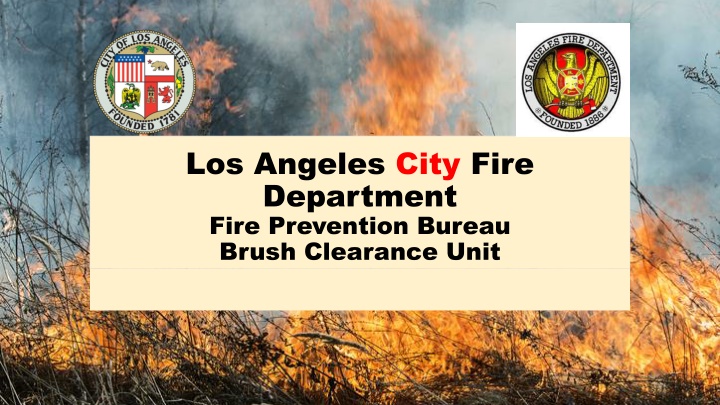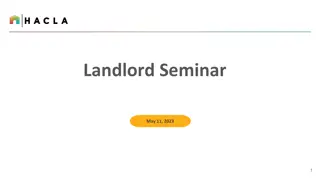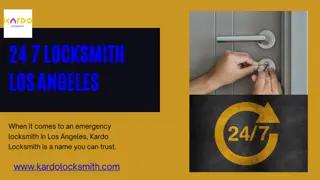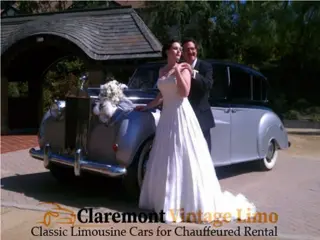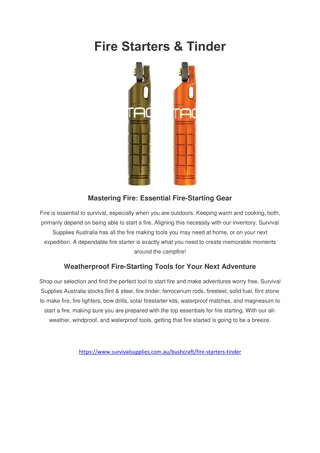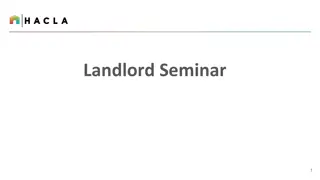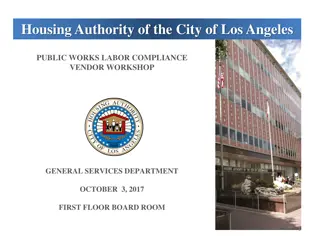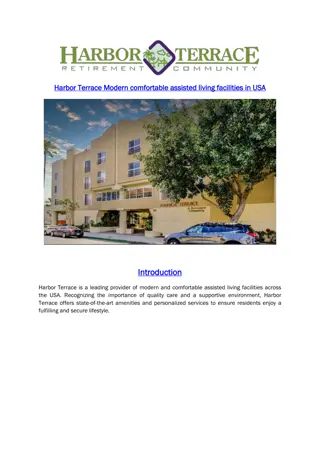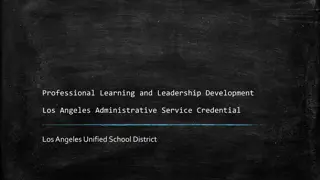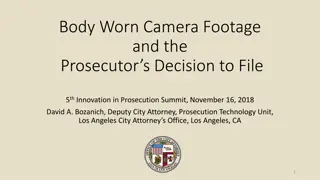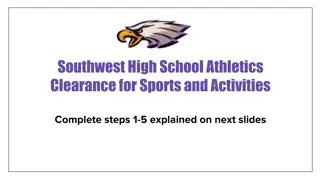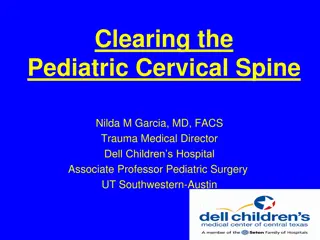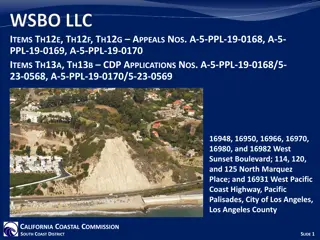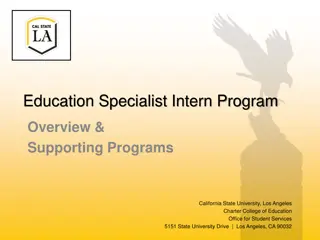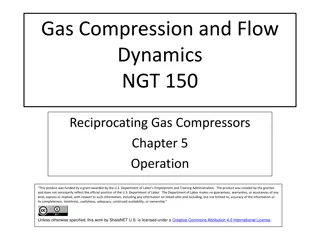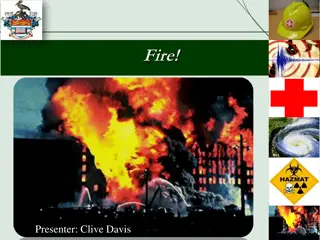Los Angeles City Fire Department Brush Clearance Unit Operations Overview
The Los Angeles City Fire Department's Brush Clearance Unit is responsible for inspecting properties in the Very High Fire Hazard Severity Zone to ensure compliance with fire codes. With a team of inspectors and additional labor, they conduct inspections, send out notifications, handle non-compliance billing, and work closely with government entities for abatement. The operational timeline for 2023 outlines key activities and procedures to maintain fire safety in the region.
Download Presentation

Please find below an Image/Link to download the presentation.
The content on the website is provided AS IS for your information and personal use only. It may not be sold, licensed, or shared on other websites without obtaining consent from the author.If you encounter any issues during the download, it is possible that the publisher has removed the file from their server.
You are allowed to download the files provided on this website for personal or commercial use, subject to the condition that they are used lawfully. All files are the property of their respective owners.
The content on the website is provided AS IS for your information and personal use only. It may not be sold, licensed, or shared on other websites without obtaining consent from the author.
E N D
Presentation Transcript
Los Angeles City Fire Department Fire Prevention Bureau Brush Clearance Unit
LAFD and Brush Clearance Unit Command Organization Los Angeles City Fire Department Fire Chief Kristen M. Crowley LAFD Fire Marshal for the Fire Prevention Bureau Chief Orin Saunders LAFD Assistant Fire Marshall for the Fire Prevention Bureau Chief Melford Beard LAFD Battalion Chief and FPB Section Commander for the BCU Chief Brian Petty LAFD Captain I for the FPB Brush Clearance Unit Captain Bryan Nassour LAFD Fire Inspector II for the FPB Brush Clearance Unit Inspector II Brent Kneisler The Brush Clearance Unit is comprised of an additional 12 Inspector I s representing all geographic areas of Los Angeles identified in the Very High Fire Hazard Severity Zone.
Inspection Process All properties within the City of Los Angeles are issued an Assessor Parcel Number from the County of Los Angeles Assessors office. These parcels or APNs are identified by the State of CA as being within the Very High Fire Hazard Severity Zone or VHFHSZ. The VHFHSZ APN s are the inspection responsibility of the LAFD Brush Clearance Unit or BCU.
Inspection Process Continued For the 2023 season there are total of 154,707 APNs that will require an inspection to be compliant with the both the State and Los Angeles Fire Code. All criteria and code requirements are adopted through the Los Angeles Municipal Code and identified within the Los Angeles Fire Code under Chapter 49. Any BCU or BTF member can make access to a property to review compliance with Chapter 49 under L.A.M.C. 57.322 Chapter 49 applies to all 154,707 parcels but is only enforceable on contractually agreed upon Government Parcels (APNs known as 900s) and Private Parcels. All 154,707 parcels are inspected by the 12 member team of the Brush Clearance Unit as well as additional labor comprised of 14/15 Inspectors to create a Brush Task Force.
BCU Operational Timeline for 2023 March All mailers for the properties identified in the VHFHSZ are distributed by GSD for notification of the 2023 season. All billing for 2022 failed (and 60 day past due) first notice of non compliance are mailed by LAFD Accounting. All billing for 2022 failed second notice of noncompliance is mailed by LAFD Accounting. All initial inspections for government parcels are performed. These include all City and State entities. LAFD BCU is required to inspect all parcels per the fire code but can only perform contacted abatement on LA ZOO, DWP- both Water & Power. GSD, DOT:CAL-TRANS, MRCA, REC/PARK, STREET SERVICES, URBAN FORESTRY, EDISON and all other GOVERNMENT Parcels are outside of the enforcement authority of the LAFD Brush Clearance Unit. Government Parcels are cleared in accordance with the 2021 approved RFQ contractors list in order of abatement priority. Starting with DWP reservoirs identified from Water and Power in priority preference.
BCU Operational Timeline for 2022 May/June All private parcels identified within the VHFHSZ are inspected between May 1st and June 30th. Properties are inspected by the BCU and Brush Task Force (BTF) and found to be cleared by owner or in noncompliance with a first inspection. Property owners are given 30 days to bring their property into compliance.
BCU Operational Timeline for 2022 July/August All failed first inspections are re-inspected for compliance. Properties at this time are found to be cleared by owner or have failed a 2nd inspection and will receive a 2nd notice of non compliance. Property owners are given an additional 30 days to bring their property into compliance.
August/September/October All Private parcels remaining in non compliance within the VHFHSZ will be packaged for a bid session and contracted for hazard abatement with a lowest bid contractor identified from within the 2021 RFQ.
November/December All contracted work performed is re-inspected for completeness and accuracy before invoicing begins.
BCU APPEALS BCU APPEALS APPEALS FOR ALL NOTICES ..EXCEPT THE INITIAL NOTICE WILL BE PERFORMED Brush Notice (BN) - ONLY the $674 fine! It is written appeal only with a $50 check submitted to LAFD Accounting by May 1st Date subject to change depending on posted date on their bill Brush Clearance (BC) In person Appeal with application submitted by May 1st Date subject to change depending on posted date on their bill If a citizen has received a Brush Clearance (BC) Notice they will automatically get a Brush Notice (BN) and they have to submit 2 separate appeals for each notice if they choose to appeal
Where is the Inspection Data?? All Inspection results are uploaded into the 3Di maintained software known as Vegetation Management System 3 or VMS3 How can the Council Office assist Property Owners with VMS3? The APN can be located either on the Owner Notification that was mailed in March, on the Notice of Violation or the Property Tax Statement. Search vms3.lafd.org and register an account. Enter the APN in the Check APN Status box Click on Look-Up to view a parcel.
What are the Fire Code Requirements? Year-round compliance shall be maintained as described below on all native brush, weeds, grass, trees and hazardous vegetation within 200 feet of any structures/buildings, whether those structures are on the owner s property or adjoining properties, and within 10 feet of any combustible fence or roadway/driveway used for vehicular travel. 1. Maintain all weeds and grasses at a maximum height of 3 inches. 2. Maintain the lower 1/3rd of trees and shrubs by removing all leafy foliage, twigs, and branches up to a maximum of 6 feet from the ground (i.e., any tree 18 feet or higher requires only 6 feet of clearance). 3. Remove all dead trees and shrubs. 4. Maintain 5 feet of vertical clearance between roof surfaces and portions of overhanging trees and shrubs (any overhanging foliage must be at least 5 feet above the roof). 5. Remove any portion of a tree or shrub within 10-foot radius of a chimney outlet. 6. Maintain the roofs of all structures free of leaves, needles, twigs and other combustible matter. 7. Remove all dead/dry undergrowth and material within trees and shrubs to include all dead or dry palm fronds/branches. 8. Once brush clearance is conducted, remove and safely dispose of all cut or bagged vegetation, all dead trees and all debris. This includes all combustible junk, trash or debris that may be on your property, regardless of how it got there. Combustible debris may include, but is not limited to, paper trash, cardboard boxes, household trash, fabric/clothing, plastic, rubber/tires, or piles of yard waste. 9. Cut vegetation may be machine processed (chipped) and spread as ground cover (mulch) so it does not exceed 3 inches in depth within 30 feet of structures and no more than 6 inches in depth 30+ feet from structures/buildings. Machine processed/chipped material shall not be placed within 10 feet of combustible fences or road surfaces.
What are the Fire Code Requirements? 10. Trim Native shrubs/brush so foliage is removed from lower third up to a maximum of 6 feet. Native shrubs shall not exceed 216 cubic feet in volume and shall be spaced not less than 3 times its maximum height but not less than 18 feet from other native shrubs, structures, and combustible material. NOTE: Native Shrubs/Brush are indigenous plants that mostly grow wild without any watering or care. High Energy Release Shrubs/Brush include, but are not limited to, Junipers, Spanish or Scotch Broom, Manzanita, Service Berry, Mountain Mahogany/Whitethorn, Sage, and Rabbit Brush, and as determined by the Fire Chief. 11. Maintain all other landscape vegetation, including, but not limited to, conifers (e.g., cedar, cypress, fir, juniper, and pine), eucalyptus, acacia, palm and pampas grass in such a condition as not to provide an available fuel supply to augment the spread or intensity of a fire or impede egress of emergency vehicles. This includes trimming up and removing all dead and dry material as required above. 12. Firewood shall be located 30 feet away from any structure or shall be completely enclosed within a fire resistive closed container. 13. Trim back vegetation and maintain 3 feet radius clearance around fire hydrants. 14. Vegetation/branches extending past curb and over the street shall be trimmed back to the curb line and up a minimum of 14 feet vertically from the roadway surface to the lowest overhanging branch to provide clearance for emergency vehicles. NOTE: Vegetation/branches extending over the sidewalk shall also be trimmed up a minimum of 9 feet vertically from the sidewalk surface to the lowest overhanging branch so as not to obstruct or interfere with the free passage of pedestrians.
Property Sales in the VHFHSZ AB38 California Assembly Bill No. 38 (AB38) seeks to mitigate the danger of wildfire by outlining available retrofits designed to protect homes located in the Very High Fire Hazard Severity Zone (VHFHSZ), and by directing vegetation management requirements around these properties. Beginning January 1, 2021 AB38 requires specific disclosures to be provided to Buyers of residential property within the VHFHSZ. In May 2021, California Association of Realtors (C.A.R.) Form Fire Hardening and Defensible Space Advisory, Disclosure, and Addendum (FHDS) became available for this purpose. Information provided here is intended as a guide for Homeowners, Buyers, and Sellers to navigate this process successfully, and to educate the public on Fire Hardening and providing Defensible Space through Vegetation Management in the VHFHSZ. To request a supplemental inspection, please contact Captain Bryan Nassour @ LAFD.AB38Inspection@lacity.org
BCU and Accounting Contact Information
Fire Station districts Contact Information Fire Stations 36,37,67,71, 85, 94, 101 and 109 Inspector Brian Bunker brian.bunker@lacity.org Fire Stations 1, 12, 16, 47 Inspector Don Smith donald.smith@lacity.org Fire Stations 78, 99, and 108 Inspector Matt Stevens matthew.stevens@lacity.org Fire Stations 42, 44, and 55 Inspector Gabe Orona gabriel.orona@lacity.org Fire Stations 27, 35, 76 and 82 Inspector Daniel Liberto daniel.liberto@lacity.org Fire Stations 83 and 88 Inspector Brent Kneisler brent.kneisler@lacity.org Fire Stations 24, 74, 77, and 98 Inspector Derricke Lockhart derricke.lockhart@lacity.org Fire Stations 19, 23, and 69 Inspector Warren Sutton warren.sutton@lacity.org Fire Stations 84, 93, and 70 Inspector Chris Sanz-Agero christopher.sanz-agero@lacity.org Fire Stations 20, 50, 56, and 3 Inspector Charles Elzie charles.elzie@lacity.org Fire Stations 41, 86, and 97 Inspector Alex Moreno lizandro.moreno@lacity.org LAFD BCU CLERICAL STAFF 800-994-4444 Linda, Lydia, Cathy and Zabela lafdbrush@lacity.org Fire Stations 96, 105, 106, and 107 Inspector Celeste Hill celeste.hill@lacity.org Fire Stations 8, 18, 28, and 91 Inspector Phil Ryan philip.ryan@lacity.org
Thank you & Clear Early and Clear Often!
